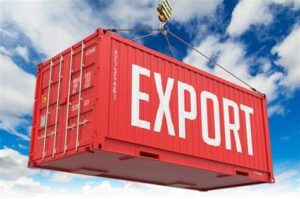
Sri Lanka Faces Economic Blow from Trump-Era Tariffs and Potential EU GSP+ Loss
- CNL Reporter
- April 19, 2025
- Weekly Economic Review
- Weekly Economic Review
- 0 Comments
Weekly Economic Review
Sri Lanka is bracing for a dual economic setback: the imposition of a steep 44% tariff on exports to the U.S. under policies introduced during Donald Trump’s presidency and the looming threat of losing the EU’s Generalised Scheme of Preferences Plus (GSP+) facility. These developments threaten to severely disrupt Sri Lanka’s export-led economy, putting jobs, trade relationships, and macroeconomic stability at risk.
U.S. Tariffs Shake Export Sector

The U.S., which accounts for nearly a quarter of Sri Lanka’s total exports, has implemented high tariffs on imports from countries with a trade surplus, including Sri Lanka. The new tariff regime disproportionately affects key sectors like apparel and textiles—Sri Lanka’s top exports—which now face cost hikes that could cripple their competitiveness.
Despite the seriousness of the issue, Sri Lanka’s government has been slow to react. While other countries such as India, Vietnam, and Bangladesh quickly mobilized diplomatic and economic teams to Washington to seek exemptions or adjustments, Sri Lanka’s approach has been criticized as fragmented and poorly coordinated.
In response, Sri Lanka is now dispatching a high-level delegation to Washington for negotiations with the United States Trade Representative (USTR). The delegation is expected to discuss reducing the tariff burden and promoting more balanced trade flows. However, this move is seen as coming too late, with critics highlighting disorganized internal communication and inefficiency—especially since two separate delegations are reportedly involved, raising concerns over duplication and unnecessary costs.
A 10% import tax, implemented by Trump as a broad revenue measure, remains in effect. Meanwhile, a more drastic 44% tariff on Sri Lankan goods could significantly reduce the country’s export earnings and strain its balance of payments.
Sri Lanka’s delayed action has left it vulnerable, especially compared to proactive regional peers. Experts now urge the government to craft a more unified, forward-thinking trade policy capable of responding swiftly to external economic shocks. Without this, Sri Lanka risks falling further behind in a rapidly evolving global trade landscape marked by growing protectionism.
EU GSP+ Withdrawal: A Looming Crisis

Compounding the crisis, Sri Lanka is at risk of losing the GSP+ trade concession granted by the European Union. A recent study by the Institute of Policy Studies (IPS) estimates that the removal of GSP+ status could result in losses of up to US$ 1.23 billion. The report warns that a shift from GSP+ to Most Favoured Nation (MFN) tariff levels could lead to a 36.7% drop in exports to the EU.
The GSP+ provides tariff-free access to EU markets for several Sri Lankan exports, particularly in high-tech sectors like transformers, which made up 50% of the country’s EU exports in 2019. If the preferential treatment ends, exports of these products could drop by 10%. The apparel industry—another major export segment—is also likely to suffer, with tariffs on garments expected to rise by around 10 percentage points.
The withdrawal of GSP+ would also carry serious implications for employment. An estimated 4.99% of the formal manufacturing workforce could be affected, including 13.47% of workers in the garment sector—many of them women and low-skilled employees. The IPS report estimates that 73,574 workers would be vulnerable, of whom two-thirds are women or low-to-medium skilled laborers.
Economic Repercussions and Policy Gaps
The U.S. and EU represent critical export markets for Sri Lanka. Without preferential access, Sri Lankan products face increased costs, making them less attractive to global buyers. These trade shocks also come amid broader financial market instability. Foreign investors pulled out over 4.9 million U.S. dollars from Sri Lankan government securities in a single week, reflecting waning confidence triggered by the tariff changes.
The Sri Lankan rupee has come under pressure, and local gold prices have surged as investors shift to safe-haven assets. Spot gold recently hit a record high of $3,322 per ounce, while a 22-carat gold ‘sovereign’ in Sri Lanka now fetches up to Rs. 241,000, a sharp increase from earlier levels. This reflects the uncertainty in financial markets as global players react to U.S. trade tensions with multiple countries.
Despite having once enjoyed strong inflows into government securities—up to Rs. 29.9 billion by December 2024—Sri Lanka saw outflows of Rs. 48.2 billion over the course of the year. Analysts attribute these shifts to global fears sparked by U.S. trade policies and domestic vulnerabilities within Sri Lanka’s economy.
Trump’s tariff decisions, particularly the narrative that Sri Lanka is “plundering” the U.S. through trade surpluses, have been criticized as misleading. Experts point out that trade is a mutually beneficial exchange between individuals and firms, not an act of exploitation. Sri Lanka’s exports—primarily low-priced garments and goods produced by underpaid labor—actually serve U.S. consumers, especially those seeking affordable products.
Nonetheless, the current U.S. administration’s objective has been framed as an effort to “make America wealthy again” by reducing trade deficits. While rhetorically appealing, data on U.S. GDP and per capita income does not support claims of economic decline necessitating such protectionist measures.
The Path Forward for Sri Lanka

The shock of a sudden 44% tariff increase—up from a previous average of 12.6%—on Sri Lankan goods underscores the vulnerability of the country’s export economy. In 2024, Sri Lanka exported $3 billion worth of goods to the U.S., accounting for nearly a quarter of its total exports of $12.7 billion. These exports now face sharp cost hikes at the port level, reducing demand and triggering ripple effects across the economy.
The broader implications of a slowdown in U.S. imports could lead to a contraction in global demand, possibly pushing the U.S. into recession and dragging other economies down with it. Countries like Singapore, with well-prepared trade strategies, are better positioned to weather such shocks. Sri Lanka, however, risks severe economic damage due to its lack of foresight and preparedness.
To mitigate this, Sri Lanka must urgently prioritize diplomatic negotiations, especially with the U.S. Sri Lanka also needs to explore entering a Free Trade Agreement (FTA) with the U.S., which would allow for tariff reductions within the framework of the World Trade Organization’s Most Favoured Nation rules.
Failure to act quickly and strategically could leave Sri Lanka further isolated and economically weakened. Experts are calling for an immediate shift towards cohesive trade planning, inter-agency cooperation, and a realistic, data-driven approach to navigating global trade dynamics.




